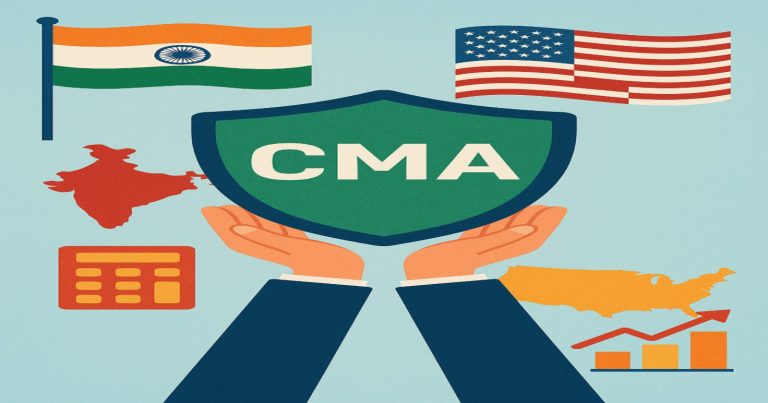The CMA India vs CMA USA comparison is essential for finance and accounting professionals aiming to enhance their career opportunities and skills. Both certifications are prestigious and recognized internationally but differ in terms of certification authorities, curriculum, eligibility criteria, and regional focus. While the CMA India certification is tailored more toward Indian financial regulations and practices, CMA USA is internationally focused, particularly popular in North America, and emphasizes global financial standards.
CMA India vs CMA USA
Both CMA India and CMA USA are prestigious accounting credentials. But which one is better for your career? The answer depends on your career goals, location, and long-term plans. While CMA India is more recognized domestically, CMA USA opens doors globally, especially in multinational companies. This article will compare both courses in depth to help Indian students and professionals decide which credential suits them best.
| Factor | CMA India | CMA USA |
| Issued By | Institute of Cost Accountants of India | Institute of Management Accountants (USA) |
| Duration | 3 to 4 years | 6 to 12 months |
| Exam Levels | 3 Levels (Foundation, Inter, Final) | 2 Parts |
| Recognition | Highly in India | Globally recognized |
| Eligibility | 12th pass (for Foundation) | Bachelor’s Degree + 2 years experience |
| Focus Area | Indian Cost Accounting and Law | Global Financial Management |
| Job Opportunities | PSU, Govt Jobs, Manufacturing Firms | MNCs, Big 4, International Companies |
| Average Salary in India | ₹6-10 LPA | ₹7-12 LPA |
| Exam Mode | Descriptive & Objective (Offline/Online) | 100% MCQs & Essays (Computer-based) |
| Articleship/Training | 3 years mandatory | No mandatory training |
Certification Authority and Recognition
One of the key differences in CMA India vs CMA USA lies in the certification authorities that grant and regulate each credential. Certification authority determines the curriculum, exam format, and recognition of each qualification.
CMA India
- Authority: The **Institute of Cost Accountants of India (ICAI)**, formerly known as ICWAI (Institute of Cost and Works Accountants of India), is the governing body for CMA India.
- Recognition: CMA India is recognized by the Indian government and has strong acceptance among Indian companies, especially in manufacturing, cost control, and regulatory compliance.
- Focus Area: CMA India emphasizes cost management, audit practices, and tax laws based on the Indian financial system, making it highly relevant to those who wish to work in India.
CMA USA
- Authority: The Institute of Management Accountants (IMA) in the USA is the certifying body for CMA USA. The IMA is globally recognized and emphasizes a broad scope of management accounting practices.
- Recognition: CMA USA is recognized internationally, with a strong reputation in North America, the Middle East, Europe, and Asia, making it a popular choice for those interested in global career opportunities.
- Focus Area: CMA USA has a global financial focus, covering concepts in financial analysis, strategic management, and risk management relevant to multinational corporations.
While both certifications are respected, CMA India is better suited for those focusing on careers in India, whereas CMA USA opens doors to global job opportunities and is favored by multinational companies.
Curriculum and Exam Structure
The curriculum and exam structure CMA India and CMA USA are designed to cover different areas of expertise. CMA India focuses on Indian accounting standards, while CMA USA takes a more international approach.
CMA India
- Curriculum: CMA India’s curriculum includes three levels: Foundation, Intermediate, and Final. The syllabus focuses on Indian tax laws, corporate regulations, cost accounting, and financial management, with an emphasis on Indian practices.
- Exam Structure: Candidates must pass exams at each level, progressing from the Foundation to the Final level. The exams are paper-based and test knowledge in areas such as cost and management accounting, taxation, corporate law, and financial reporting in an Indian context.
- Duration: Completing CMA India typically takes 3-4 years, depending on the candidate’s education level and preparation time.
CMA USA
- Curriculum: CMA USA has two parts, covering topics like financial planning, performance and analytics, and strategic financial management. This globally oriented syllabus emphasizes decision-making, financial analysis, internal controls, and ethics.
- Exam Structure: The CMA USA exam consists of two parts, each with multiple-choice questions and essay sections, conducted at Prometric centers worldwide. Exams are offered several times throughout the year, giving candidates flexibility.
- Duration: Most candidates complete CMA USA in 6 months to 1.5 years, given its shorter curriculum compared to CMA India.
The choice between CMA India and CMA USA depends on candidates’ career goals and the type of financial practices they wish to specialize in, with CMA USA providing a shorter path to certification.
Eligibility Criteria
Eligibility criteria for CMA India and CMA USA vary in terms of educational and professional requirements. These criteria affect the duration and readiness of candidates to pursue the certifications.
CMA India
- Educational Requirements: To enroll in the CMA India Foundation level, candidates must complete at least the 10+2 (high school) level in India. Graduates from any stream can directly enter the Intermediate level.
- Professional Experience: CMA India does not have a mandatory experience requirement for certification, making it accessible to recent graduates.
- Membership Requirements: After passing the exams, candidates can apply for membership in ICAI to be recognized as a certified CMA in India.
CMA USA
- Educational Requirements: Candidates must have a bachelor’s degree in any discipline from an accredited institution, though the IMA does allow flexibility with degree recognition across countries.
- Professional Experience: CMA USA requires candidates to have at least two years of professional experience in management accounting or financial management. This requirement can be fulfilled before or within seven years after passing the exams.
- Membership Requirements: Candidates must maintain membership with the IMA and complete 30 hours of Continuing Professional Education (CPE) annually to retain their certification.
The eligibility requirements for CMA USA are more stringent, as they require both a degree and relevant experience, making it ideal for those with some industry background.
Career Opportunities and Salary Prospects
The career opportunities and salary prospects for CMA India and CMA USA holders can vary significantly based on industry, geographic location, and the scope of each certification.
CMA India
Career Opportunities: CMA India holders are highly sought after in sectors such as manufacturing, government agencies, and Indian corporations. Common roles include cost accountant, finance manager, tax consultant, and audit specialist.
Salary Prospects: In India, CMAs can expect competitive salaries, with entry-level positions starting at INR 4-6 lakh per annum, while senior positions can earn over INR 15 lakh per annum, depending on experience and industry.
CMA USA
Career Opportunities: CMA USA certification opens doors to international roles in finance, multinational corporations, and management. Common job titles include financial analyst, controller, management accountant, and CFO.
Salary Prospects: Globally, CMAs with the USA certification tend to earn higher salaries, particularly in the USA, Middle East, and Europe. In the USA, entry-level CMAs start with around $60,000 per year, with senior roles potentially exceeding $100,000 annually.
While both certifications offer lucrative opportunities, CMA USA tends to provide higher salaries and international career mobility, especially for those aiming to work with multinational companies.
Conclusion
CMA India vs CMA USA comparison highlights the strengths and distinct benefits of each certification. CMA India, certified by ICAI, is ideal for professionals focusing on Indian financial systems, tax laws, and cost management. On the other hand, CMA USA, governed by the IMA, offers a globally recognized credential that emphasizes management accounting, strategic analysis, and international financial standards. Choosing between the two depends on career goals, desired geographic mobility, and the specific financial skills a candidate wishes to develop. Both certifications enhance professional credibility, making them valuable assets for a successful career in accounting and finance.
CMA India vs CMA USA FAQs
What is the difference between CMA India and CMA USA?
CMA India is focused on Indian financial standards and regulations, while CMA USA has a global focus, covering international standards in management accounting and financial analysis.
Which certification has a shorter duration, CMA India or CMA USA?
CMA USA generally has a shorter duration, with most candidates completing it in 6 months to 1.5 years, whereas CMA India may take 3-4 years.
What are the eligibility requirements for CMA USA?
CMA USA requires a bachelor’s degree and two years of professional experience in financial management or management accounting.
Does CMA India require professional experience?
No, CMA India does not require professional experience, making it accessible to recent graduates who meet the educational criteria.
Which certification is better for international career opportunities?
CMA USA is generally preferred for international roles due to its global recognition and focus on multinational financial standards.


